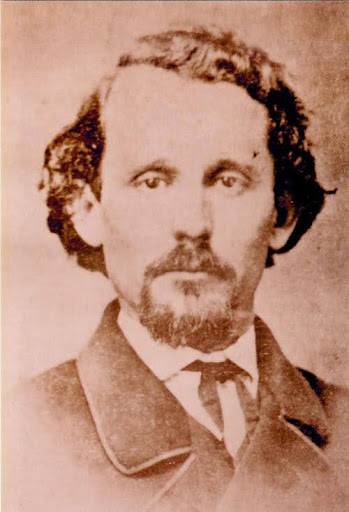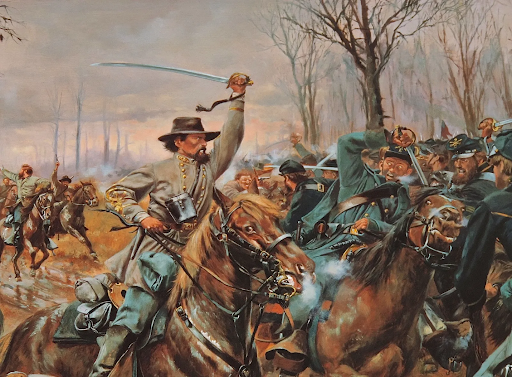Battle of Okolona by Jim Garrett

Sound the Charge, Dale Gallon 1989.
The Battle of Okolona and The Death of Colonel Jeffrey Forrest By Jim Garrett

Jeffrey Forrest
February marks the 160th anniversary of the Battle of Okolona, a fluid engagement of roughly 11 miles through Okolona and toward Pontotoc, Mississippi. The battle was one of Major General Nathan Bedford Forrest’s signature victories, yet it was also one of his personal tragedies. His youngest brother and one of his brigade commanders, Colonel Jeffrey Forrest, died in Forrest’s arms having been mortally wounded in the throat while leading his brigade.
After the Battle of Chickamauga, Bedford Forrest received his wish to be transferred out of Braxton Bragg’s command in the Army of Tennessee.(1) Jefferson Davis directed Forrest to raise a cavalry department and operate under Stephen D. Lee and Leonidas Polk in the Department of Alabama, Mississippi, and East Tennessee.
By January 1864, Forrest had recruited and conscripted new troops from Mississippi and West Tennessee and had a force totaling about 4,000. While headquartered at Como, he trained and organized his command into four brigades – with Jeffrey Forrest commanding the 4th Brigade – and three batteries of artillery. (2)
Major General William T. Sherman formulated a plan while headquartered at Vicksburg in December 1863 and January 1864 to march in force across central Mississippi to the rail town of Meridian, laying waste and destruction to the land and Confederate supplies. To maximize the destruction of the Mississippi “breadbasket” and the vital Mobile & Ohio rail line, Sherman directed a strong cavalry force from Memphis to march southeast and link-up with his infantry in Meridian. This combined force would then give Sherman flexibility to continue the march to the industrial center around Selma, Alabama.(3) Sherman’s 20,000 infantrymen left Vicksburg on February 3rd with the objective of rendezvousing with the Memphis cavalry force in Meridian on the 10th. This proved impossible since the cavalry force under Brigadier General William Sooy Smith didn’t leave the Memphis area until the 10th. As Smith’s 7,000 cavalrymen rode southeastward, they were shadowed by Forrest’s men who had been alerted of the concentration of cavalry units in Memphis.(4)
Smith marched his force out of the Memphis area on separate routes toward the Tallhatchie River crossing at New Albany. He also directed an infantry brigade move from Memphis to the Tallhatchie at Wyatt as a diversion in hopes of drawing the Confederate forces away from his main body. Not yet convinced of Smith’s real objective, Forrest’s brigades were screening as far west as Grenada and Panola (just above present-day Batesville). Once Smith’s troops crossed the river at New Albany and headed toward Pontotoc, Forrest was satisfied the objective lay in either Okolona or Meridian. He then ordered his dispersed brigades to consolidate at West Point.(5)
Smith moved through Pontotoc and Okolona, and down the Mobile & Ohio, leaving a path of destruction behind him.(6) His troops reached West Point on February 20th. Jeffrey Forrest’s Brigade engaged the Federals but withdrew west of town since Forrest’s command had not yet concentrated. Smith, in the meantime, had grown very anxious and considered he was walking into a trap.(7) He decided to end the expedition and head back to Memphis, validating Sherman’s opinion of him – “I deem General W. Sooy Smith is too mistrustful of himself for a leader against Forrest.”(8) The next day he ordered the force to turn around and move back towards Okolona. Smith directed a force from the 2d Iowa Cavalry and 6th Illinois Cavalry to attack Jeffrey Forrest’s defensive positions at Ellis Bridge and hold the Confederates while he initiated the retrograde. As the Federals withdrew, Bedford Forrest seized the initiative and, with his escort and two companies under Captain A. H. Tyler, pursued Smith on the route to Okolona. Smith’s rear guard made at least two stands to slow Forrest down and bought time for Smith to make it to the outskirts of Okolona where his troops spent the night of the twenty-first.(9)
The following day, February 22, 1864, Forrest wanted to destroy Smith’s force before it reached the Pontotoc Road where Smith could take advantage of the defensive positions afforded by the rolling hills and wooded ridges. His plan called for Jeffrey Forest’s Brigade (when the unit arrived from its position west of West Point) to attack from the west, Colonel C. R. Barteau, commanding two regiments of Tyree Bell’s Brigade, attacking from the east and Forrest pushing up the center with a detachment of roughly 400 cavalrymen. As the day began, Forrest opened the Battle of Okolona by forcing Smith’s rearguard back toward Okolona. Forrest then noticed a significant force of approximately 2,500 Federals (Colonel Benjamin Grierson commanding McCrillis’ Third Brigade) had moved in front of Barteau. Forrest took his escort and moved over to Barteau’s command. Once he arrived, he told the men to “mount up” and then led one of the regiments in a charge against Grierson’s left while Barteau led the other regiment against the center and into the town of Okolona. As the battle began, Forrest’s full brigade under Colonel Robert McCullough and his brother Jeffrey’s brigade arrived, providing Forrest a total of approximately 2,500 cavalrymen.(10)
Smith’s First Brigade under Colonel George Waring had moved onto the Pontotoc Road before Forrest’s men launched their attack. Grierson’s men gave ground and collapsed. Grierson, however, was able to reform and stubbornly fought a “leapfrogging” delaying action as they, too, reached the Pontotoc Road.(11) As Waring approached high ground near Prairie Mount about six miles north of Okolona, he stopped and formed his brigade in a defensive position to allow Grierson to pass through and then slow Forrest’s pursuit. Now having two full brigades at his disposal, Forrest had McCullogh’s Brigade advance against Waring’s troops on the western side of the road and Jeffrey Forrest’s Brigade advance on the east. Both brigade commanders were wounded in the attack. McCullough received a painful wound in the hand but kept fighting while Jeffrey Forrest was mortally wounded by a Minie’ ball that severed his carotid artery.(12)
Accounts offer differing versions of how Bedford Forrest learned his youngest brother had been wounded. One recounts that Forrest saw Jeffrey fall from his horse.(13) Another believes he was informed by staff of the wounding.(14) Historians, however, agree Forrest immediately rushed to his brother, knelt down and cradled Jeffrey’s head while repeating his name.(15) Jordan and Pryor quote a regimental commander as later recounting, “The moment was too sacred for angry passions to have sway, and, catching its inspiration, I ordered the men to cease firing that all might join in sympathy with our suffering General. After nature had triumphed for a while, he rose up, and, casting aside those reflections which had unmanned him for a few moments, by a strong mental effort, Forrest was himself again.”(16)
Forrest was most likely more than himself – overtaken with grief and anger. Jeffrey Forrest was the last child in the Forrest family, having been born after his father’s death. By most accounts, Bedford was a father figure, and the twenty-five-year-old Jeffrey was his favorite brother.(17) Most all sources recount that the general then mounted his horse, ordered his bugler, Gaus, to sound the charge and led the attack on Waring’s First Brigade himself.(18)

Southern Steel, Don Troiani 1985
The renewed onslaught of Forrest’s troopers unnerved Waring’s men. They fled the position to join the rest of Smith’s troops farther north on the Pontotoc Road. Most historians believe after the Federal rout at Okolona they made two determined stands against their pursuers on the road to Pontotoc. The first, most agree, was at Prairie Mount. The second stand by Smith’s men seems to have been either at Ivy’s Hill or just north of Troy at “Rutledge’s Place.”(19) Regardless, Forrest’s troops had routed Smith’s forces and relentlessly pursued the Federals along an eleven-mile stretch until darkness and exhaustion overtook them. Casualties for the engagement from Ellis Bridge to the evening of February 22rd were an estimated 383 Federals killed, wounded and missing while Forrest lost a total of 163.(20) A third casualty list stands out. Two horses were killed from under Bedford Forrest along the pursuit route, a fact which shows the determination and ferocity of the fight on both sides(21)– a fight which would be continued by men named Grierson, Waring, Barteau, Morton and Forrest at a Crossroads some forty miles north in just over three months.
References
1 John Allan Wyeth, That Devil Forrest, The Life of General Nathan Bedford Forrest, Louisiana State University Press, Baton Rouge, 1959, p.245.
2 Brandon Beck, The Battle of Okolona, Defending the Mississippi Prairie, History Press, Charleston, 2009, p. 39-40. Mr. Beck provides an authoritative account of the battle and a valuable guided tour in his work.
3 Wyeth, pp 267-268.
4 Beck, pp. 45-47.
5 Id.
6 Wyeth, p.275.
7 Beck, pp. 51-52.
8 Beck, p. 25.
9 Beck, pp. 53-55.
10 Beck, pp. 57-59, and Wyeth, pp. 284-285. Jeffrey Forrest is buried at Elmwood Cemetery, Memphis, Tennessee. Of note, his gravestone lists the incorrect year “1863” as the year of death.
11 Beck, p. 60.
12 Beck, p. 61.
13 Wyeth, p. 289.
14 General Thomas Jordan and J.P. Pryor, The Campaigns of Nathan Bedford Forrest and of Forrest’s Cavalry, Da Capo Press, New York, 1996, p. 395.
15 See Wyeth, p. 290 and Jordan and Pryor, p. 396.
16 Jordan and Pryor, p. 396.
17 Wyeth, p. 289.
18 Jordan and Pryor, p. 396.
19 See Beck, p. 63 for an excellent overview of the differing sites.
20 Beck, pp. 67-68.
21 Forrest addressed the tenacity and gallantry of his troops at Okolona in a commendatory address issued to his command in June 1864. In addition to mentioning the death of his brother, Forrest also noted the death of Lieutenant Colonel J.A. Barksdale, Commander of the 5th Mississippi Cavalry Regiment. (this author believes Barksdale received his mortal wound in the subsequent charge led by Bedford Forrest immediately following the death of Jeffrey Forrest). See The War of Rebellion: A Compilation of the Official Records of the Union and Confederate Armies, Expedition Into Mississippi, Volume 39, Series I, Page 228, at
www.ehistory.osu.edu/books/official-records/077/0228, last accessed on February 1, 2024.